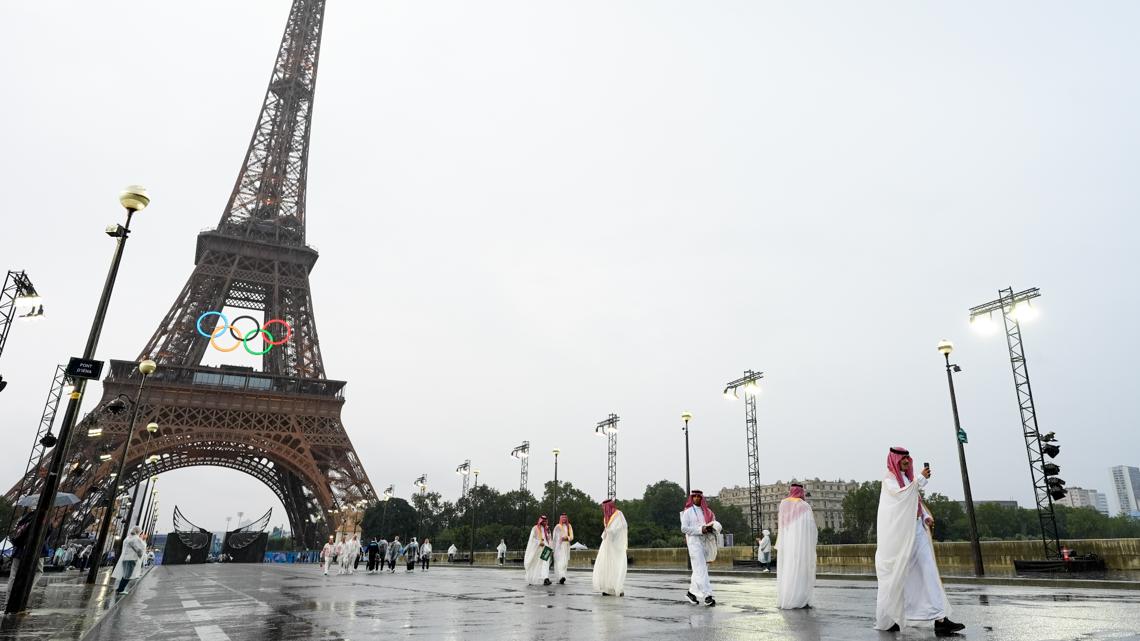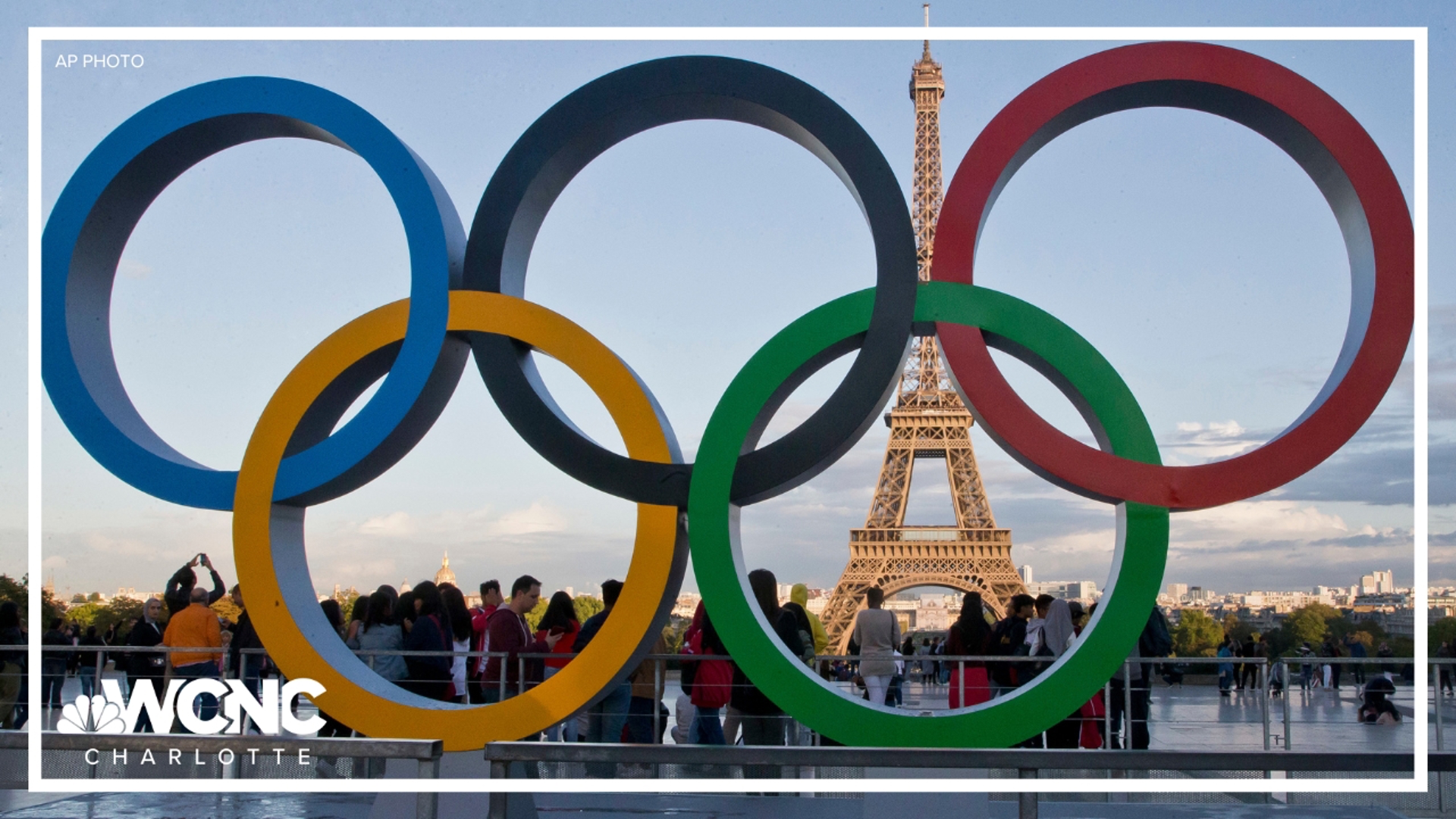PARIS, France — Celebrating its reputation as a cradle of revolution, Paris kicked off its first Summer Olympics in a century on Friday with a rain-soaked, rule-breaking opening ceremony studded with stars and fantasy along the Seine River.
As global audiences tuned in, Paris put its best foot forward — quite literally, with a spectacular Olympic launch that lifted spirits and joyous French cancan dancers featured early on. A humorous short film featured soccer icon Zinedine Zidane. Plumes of French blue, white and red smoke followed. And Lady Gaga sang, in French, with dancers shaking pink plumed pompoms, adding a cabaret feel to what is expected to be a more than three-hour show.
French-Malian pop star Aya Nakamura, the most listened-to French-speaking artist in the world, sang her hit “Djadja” accompanied by the orchestra of the French Republican Guard. She emerged from a pyrotechnic display, wearing an all-gold outfit as she performed with a Republican guard band of the French army.
Merging the elements of opera and rock metal music on the global stage, band Gojira brought their progressive and technical death metal style, while singer Marina Viotti inserted her mezzo-soprano vocals.
A singer resplendently dressed in the French colors of blue, white and red belted out France's national anthem, La Marseillaise, from the iron- and glass-domed roof of the Grand Palais, the venue for fencing and taekwondo. In the VIP section further along the river, French President Emmanuel Macron and others stood as she sang.
The ceremony celebrated women, including 10 golden statues of female pioneers that rose from giant pedestals along the river. Among them was Olympe de Gouges, who drafted the Declaration of the Rights of Women and the Female Citizen in 1791 during the French Revolution. She campaigned for the abolition of slavery and was guillotined in 1793.
The statues will be offered to the city after the ceremony. The Paris Games aim to be the first with equal numbers of men and women competing.
With the ambitious ceremony, the stakes for France were immense. Dozens of heads of state and government were in town, and the world was watching as Paris turned itself into a giant open-air theater. Along the Siene, iconic monuments became stages for dancers, singers and other artists.
The sprawling ceremony gave organizers bigger crowds to transport, organize and safeguard than would have been the case if they’d followed the example of previous Olympic host cities that opened with stadium shows.
Still, as the show got underway, optimism soared that Paris – true to its motto that speaks of being unsinkable – might just see its gambles pay off. That's despite the soggy weather — no other Summer Olympics opening ceremony has had rain since Helsinki in 1952.
Paris organizers said 6,800 of the 10,500 athletes would attend before they embark on the next 16 days of competition.
The boats carrying the Olympic teams started the parade by breaking through curtains of water that cascaded down from Austerlitz Bridge, the start of the 6-kilometer (nearly 4-mile) parade route. The jetting waters were a wink at the splendid fountains of Versailles Palace, now the venue for Olympic equestrian competitions.
Per Olympic protocol, the first boat carried athletes from Greece, birthplace of the ancient Games. It was followed by the Olympic team of refugee athletes and then, the other nations in French alphabetical order.
Usually during Olympic opening ceremonies, the parade of athletes takes place during a pause in the razzmatazz. But Paris shattered that tradition by having the parade and pageantry at the same time, blending sports and artistic expression.
Up close, the waters of the Seine River looked choppy indeed. As boats approached the Alexander III Bridge, they all appeared to veer off to the side. And the smaller boats were clearly having a bumpy ride.
Then, a glittering metal horse galloped across the water with an armored horsewoman astride. The horsewoman, Gendarmerie noncommissioned officer Floriane Issert, was meant to be “the representation of the Olympic spirit and of Sequana.” She and her trusty horse — which eventually turned into a real equine — passed under successive bridges as dove wings unfurled to symbolize a message of peace.
After staring in awe at the Eiffel Tower light show, crowds once again jumping up and down and bopping to electronic music.
Lights from the monument can be seen as rays through the rain over the Seine, leaving the cloudy sky glowing.
Some spectators who followed organizers’ advice to arrive well ahead of time along the ceremony route fumed over long waits to get to their seats.
The French-Canadian pop star Celine Dion followed the lighting of the Olympic cauldron by performing from the Eiffel Tower.
“Paris has been great, anything to do with the Olympics and dissemination of information has been horrible,” said Tony Gawne, a 54-year-old Texan who turned up six hours in advance with his wife.
“When you spend $6,000 on two tickets, well, that’s a little frustrating,” he said.


But Paris had plenty of aces up its sleeve. The Eiffel Tower, its head still visible below the clouds, Notre Dame Cathedral — restored from the ashes of its 2019 fire — the Louvre Museum and other iconic monuments starred in the opening ceremony. Award-winning theater director Thomas Jolly, the show’s creative mind, was using the signature Paris cityscape of zinc-grey rooftops as the playground for his imagination.
His task: Tell the story of France, its people, their history and essence in a way that leaves an indelible imprint on Olympic audiences. Refresh the image and self-confidence of the French capital that was repeatedly struck by deadly extremist attacks in 2015. Capture how Paris is also aiming to reboot the Olympics, with Summer Games it has worked to make more appealing and sustainable.
It’s a big ask. So Paris went big, very big. That goes for the security, too. Large fenced-off stretches of central Paris were locked down to those without passes and the skies during the ceremony were a no-fly zone for 150 kilometers (93 miles) around.
Many details of the spectacle that stretched into the Paris night were closely guarded secrets to preserve the wow factor, including who would light the Olympic cauldron.
During the athletes’ waterborne adventure, they passed historic landmarks that have been temporarily transformed into arenas for Olympic sports.
Concorde Plaza, where French revolutionaries guillotined King Louis XVI and other royals, now hosting skateboarding and other sports. The golden-domed resting place of Napoléon Bonaparte, the backdrop for Olympic archery, and the Eiffel Tower, which donated chunks of iron that have been inlaid in the gold, silver and bronze Olympic medals. They’ll be won in the 32 sports’ 329 medal events.
Paris’ aim, said Estanguet, is “to show to the whole world and to all of the French that in this country, we’re capable of exceptional things.”
NBC and the Associated Press contributed to this report

